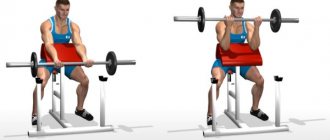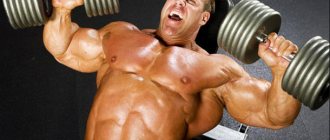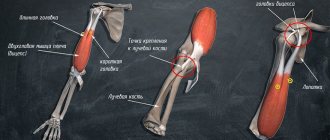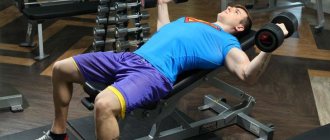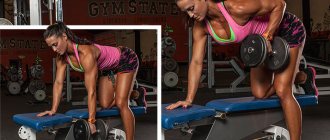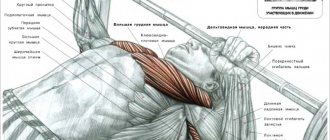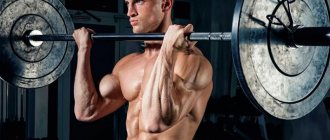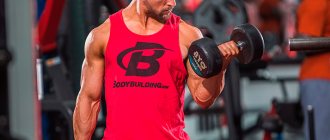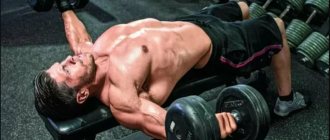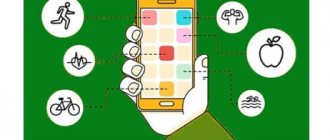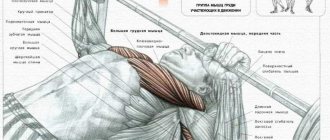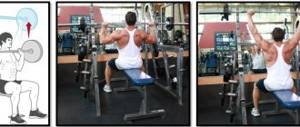13.02.2020
The Scott bench is a simulator that can be found in any gym. It is named after Larry Scott, who is the first Mr. Olympia. The design of the simulator consists of a seat, a barbell clamp and an inclined music stand where the elbows are placed. The equipment is considered one of the best ways to work the biceps locally and isolatedly. Curling your arms on a Scott bench helps increase the volume and shape of the biceps brachii muscle.
Biceps heads
Before we get into the exercise itself, let's first talk a little about the biceps itself.
The next time you strain the can, take a close look at it in the mirror or just look at its structure: this bender looks like one massive monolith.
In a sense, this is true, but despite this, it consists of two “heads”.
There are internal and external heads. If you tense the muscle, you will notice that it is a little longer where it goes to the elbow joint (whether you can see this depends on the percentage of subcutaneous fat, if you can’t see it, just take our word for it). This point is the inner head of the biceps. The rest of the part on the outside of the arm is the outer head.
Why does this matter?
First things first, the fact that the muscle is divided into two heads means that in order to engage them both, you need to do slightly different movements. The type of movements you do will also affect the size of your biceps. The inner head is responsible for peak height, so if you work it, you will increase the height of your biceps. The outer head, on the other hand, is the thicker of the two, so if you work on this area, the arm will become wider.
In this regard, if you want to increase the height of your biceps, work the inner head and brachialis, if you want a thicker biceps, work on the outer head.
How to use both heads
Why focus only on hitting a higher or wider area on the biceps when you can hit everything?
All you need is to know how to work the inner and outer heads. Luckily, the Scott Bench Curl allows you to do both.
Whether you engage one head or the other really depends on how you perform the curl on the bench. And it is because of this, as you might have guessed, that one of the heads can be more developed than the other (due to the fact that, as we now know, one is responsible for height, the other for width).
The closer to your body you keep your elbows when bending, the more the inner head is activated. The wider the grip (as, for example, when using a barbell for biceps on a Scott bench), the more the external one is involved. This is why if you perform a cross curl (where you hold the weight with your right hand but curl diagonally toward your left side, across your chest), you will feel significant tension on the inside of your biceps. This is what makes Scott curls such a great exercise for strength and size.
We'll get to the actual lift in a second, but first note that how you place your elbow will determine the direction of the bend and give you complete control over which head you engage with it.
When bending, you always strain both heads one way or another, but by distributing the load differently between them, you can quickly achieve results in the desired one.
How to achieve good results: useful tips
- Don't take very heavy weights. Curling your arms on a Scott bench, as mentioned above, does not help build muscle mass. It is important to concentrate on the technique of performing the exercise.
- You cannot straighten your arms completely. Otherwise, the risk of injury to the elbow joint increases, since the movement is carried out in a shortened amplitude.
- If you experience wrist pain while lifting a barbell, it is better to replace it with an EZ bar.
- Try not to twist your hand at the “peak” point, otherwise the effectiveness of the exercise will decrease significantly, and there will be a “chance” of injuring your wrist joints.
- Control all your actions: both extension and bending of your arms. The main task is to feel the compression and stretching of the shoulder muscles as much as possible.
- During the lift, you don't need to lift your elbows because the front deltoids will be involved.
- When extending, the arms should be under strong tension.
- You cannot bring your elbows towards each other on the rise.
- The last two or three repetitions should be done at a slow pace, concentrating on straightening the elbow joint. Here you may need the help of a partner to throw the barbell up when your strength runs out.
Scott Bench Curls
Okay, let's refresh our memory a little about what the Scott Bench Curl is (because in fairness, it should be noted that these curls are a dime a dozen).
The Scott bench is essentially a shoulder pad and saddle. The armrest is located at an angle of 45, you rest your elbows on it when bending.
The purpose of this type of curl is to pump up the biceps in isolation. Since you are sitting with your elbows resting on a stationary object, your back is not used. Many people, without even realizing it, cheat because they use their back muscles to help themselves when bending.
This takes the load away from the biceps and thereby reduces the benefits of the exercise. And while there are many great biceps isolation movements, this is undoubtedly one of the best.
It works almost exclusively one muscle, although depending on how you lower the weight, you can also hit the triceps.
Effective program
To better increase strength and build muscle mass, we recommend regularly performing arm curls, alternating between the following types of exercises:
- curved bar curls;
- alternately bending each arm with dumbbells;
- curling arms with a reverse grip.
In addition, these exercises can be combined. Sets are performed without changes in order and without breaks. For beginners, 3 sets (that is, 3 types of exercises) are suitable; advanced athletes need to perform 5-6 sets.
To summarize, I would like to note that bending the arms on the Scott bench effectively increases the strength of the biceps and accompanies the separation of the biceps muscle (the relief is well drawn). You can also choose from a variety of exercise options the one that suits you and adjust the weight yourself.
Be sure to include this exercise in your training program. And remember that you need to train your body comprehensively. We hope the article was useful to you. We wish you success!
How to do exercises on a Scott bench
Let's take a look at the traditional barbell curl technique on a Scott bench, then move on to some variations and other recommendations.
The traditional technique starts with you resting your elbows on a pad. If you don’t have the bench at hand, it’s okay, you can take a bench with an adjustable back and place it at an angle of 45 degrees (in this case you will have to do each arm separately, but this works just as well, or even better). You will also obviously need a loaded barbell.
Grab the barbell (remember, the narrower the grip, the more load is placed on the inner heads, the wider the grip, the more the outer heads work) and lift the barbell on a Scott bench. Exhale as you move up. Holding the weight at the top, contract your biceps as much as possible, then slowly lower. By lowering the bar slowly, you will also engage the triceps.
This is one repetition...
There is a technique we'd like to look at, and it primarily concerns the brushes. Typically, when you perform a curl on a Scott bench, your hands are facing your biceps (as if you were standing in front of a mirror). This puts a lot of stress on the hands and can lead to pain in the wrists. In addition, this takes some of the work away from the biceps, since the hands are involved. Instead, try taking them out of the equation (this will also help a lot if you have wrist pain).
How to do it?
Hold your hand the way a waiter does when carrying a tray.
Do you feel the difference?
This allows you to keep your hand in the same line as your arm, thereby reducing stress on your wrist. If you perform dumbbell curls on a bench in this position, you will also feel more tension in the biceps, since the wrist is not doing some of the work.
It's a small change, but one that may take you a while to get used to (simply because you've likely been doing barbell Scott Bench curls for as long as you can remember), but it will help. you will achieve better results and reduce wrist pain.
Execution options
There are several ways to perform a bench press on a Scott bench:
- With dumbbells. The exercise is designed to work each arm separately. In this version, it is easier for the athlete to control the tension of the biceps. The main advantage of this bench press is the ability to work without a partner, on your own. If it seems that your strength is running out, then you can help yourself with your free hand. Dumbbells are taken with a neutral or classic grip (palm up).
- With a barbell with a reverse grip. This workout works on the brachialis. The barbell is taken with the palms down (on top). In this case, the weight of the burden decreases, but the effectiveness of the exercise does not decrease.
- On the simulator. Here the function of the rod is performed by the handle, and the discs are replaced by blocks. You can do curls with one hand or both at once. Some athletes think that the Scott Bench machine is worse than using free weights. On the other hand, many professional athletes are increasingly abandoning the barbell and switching to the machine.
Variations of the exercise
Traditionally, the Scott curl is performed with an EZ barbell, an exercise that uses a curved bar.
However, there are other options (and some of them are even better). Let's start, however, with those that should be avoided, namely the curling machine. 99 times out of 100, we will advise you to use free weights instead of the machine version. Exercises performed on a simulator with cables differ in an advantageous way, since you control the lifts and amplitude of movement, but generally it is better not to even look in the direction of the simulators.
This is especially true for the biceps curl machine.
Its main disadvantage is that you don't use any stabilizing muscles. Just below the biceps, on the outside of the arm, there is a special muscle called the brachialis. It is located right on top of the bone directly below the biceps.
If you engage it (which is best done with a hammer bend), it will strengthen and increase in size. This is important because by doing this, it will push the biceps upward, which in turn will give you a massive arm.
The traditional biceps curl allows you to do this, since the brachialis here works as a stabilizing muscle. The trainer does not use it, which means you lose the payload. Plus, with free weights you can change your trajectory and grip, which means you control which head you're working.
You can also try using a dumbbell instead of a barbell.
The dumbbell allows for greater movement variability. First of all, this is the width of the arms to work one or the other head of the biceps. You can also lift the dumbbell across the body to squeeze the inner head even more. With a barbell this is obviously impossible.
Yes, the approach will be two times longer, but it’s worth it.
Exercises for mass
Now that you know how to train the biceps heads (knowledge that will help you in all your future curling exercises), let's learn how to train for mass.
For starters, it's best to place curl exercises toward the end of your arm day because there are many other movements that better target both the biceps and triceps, as well as the forearms and shoulders.
Such lifting and extension movements should be given attention earlier (and more effort spent on them).
Towards the end of the arm day, it is better to do at least two sets per exercise. You can do three if you want. If you're doing variations on the curl, such as the front curl, you can do three sets, since the inner head of the biceps likely wasn't used as much in all the other exercises.
However, if you're doing a regular curl, two sets of curls is enough to top off your other moves on arm day.
As for the number of repetitions per set, it all depends on your goals.
Do you want to train your arms to increase strength?
If so, do about four reps per set on the bench. However, it needs to be hard for you. If you can squeeze out the fifth rep, the weight is too light. If your maximum is four reps on the first set, increase the weight on the second set.
If your goal is volume, do eight to 12 reps. If you can't do eight with a bent bar, the weight is too heavy; if you can do more than 12, you need to add more weight. The good thing about training your arms is that you can curl them without fear of the bar falling on your chest or your legs giving out and injuring yourself.
